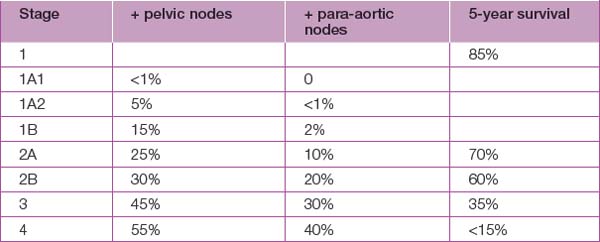Chapter 19 Cervical neoplasia
Role of human papillomavirus
Over 60 different genotypes of human papillomavirus (HPV) have been identified. In some populations, it is present in over 70% of women and may be a vaginal commensal. Other co-factors, such as smoking, may be required to promote the development to cervical intraepithelial neoplasia (CIN).
Cervical cytology
Screening for CIN
Endocervical cells present
Effectiveness against cervical cancer
Cervical intraepithelial neoplasia (CIN)
Management
Colposcopy
Ablative treatment
Excision
Cone biopsy
Indications. At colposcopy, the lesion is not fully visualised, especially the upper limit; suspected adenocarcinoma in situ; colposcopic examination shows no evidence of dysplasia despite repeated cytology with high-grade dysplasia; or early invasive disease is suspected.
Cervical intraepithelial glandular neoplasia
Cervical cancer
Of cervical malignancies, 85% are squamous cell carcinoma and 15% are adenocarcinoma. The development of cervical cancer is in either the squamous epithelium or endocervix. Most squamous cancers originate in the transformation zone.
Risk factors
Diagnosis and examination
Presenting complaint
Investigations and staging of cervical cancer
FIGO staging for cervical cancer
This is a clinical staging system. See Table 19.1 for correlation of stage and 5-year survival.
Management of cervical cancer
Surgical treatment
Radiation therapy
Morbidity of pelvic radiotherapy
Treatment of early-stage cervical cancer
Stage 1B
Management of advanced-stage cervical cancer
Follow-up management of cervical cancer
Adenocarcinoma of the cervix
Basil J.B., Horowitz I.R. Cervical carcinoma. Obstetrics and Gynecology Clinics of North America. 2001;28:727-740.
Berek J.S., Hacker N.F., editors. Practical gynecologic oncology, 4th edn, Philadelphia: Lippincott Williams & Wilkins, 2005.
Flowers L.C., McCall M.A. Diagnosis and management of cervical intraepithelial neoplasia. Obstetrics and Gynecology Clinics of North America. 2001;28:667-684.
Grisby P.W., Herzog T.J. Current management of patients with invasive cervical carcinoma. Clinical Obstetrics and Gynecology. 2001;44:531-537.
Levine L., Lucci J.A., Dinh T.V. Atypical glandular cells: new Bethesda terminology and management guidelines. Obstetrical and Gynecological Survey. 2003;58:399-406.
National Health and Medical Research Council (NHMRC). Screening to prevent cervical cancer: guidelines for the management of asymptomatic women with screen detected abnormalities. NHMRC: Canberra; 2005.



